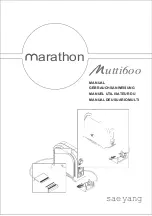
Page 5 of 68
PN-3078-0001 Rev. C 01/13
One patient was re-hospitalized during the follow-up period due to an
episode of supra-ventricular tachycardia that was documented to be a
pre-existing condition and unrelated to the AngioSculpt catheter.
A second patient suffered a perforation of a diagonal branch coronary
artery that was associated with a non-Q wave MI during treatment with
a conventional angioplasty balloon and in a location and artery that
were remote from the site treated with the AngioSculpt. This patient
did not require surgical intervention and did not experience any
additional MACE during follow-up.
The AngioSculpt catheter was successfully deployed in all 46 lesions.
In all 46 attempted lesions, the primary performance endpoint of
reduction of the lesion diameter stenosis to ≤ 50% at the completion
of the interventional procedure was successfully achieved. In all lesions
treated, the AngioSculpt catheter demonstrated stable position during
deployment without any significant slippage on angiography. The
angiographic results are summarized in Table 2.
Table 2: Angiographic Results
Pre-AS
(n=46)
AS
Alone
(n=10)
AS
Pre-Stent
(n=36)
Post-Stent
(n=36)
RVD
(mm)
2.87±0.41
N/A
N/A
N/A
Length
(mm)
15.67±6.14
N/A
N/A
N/A
DS (%)
75.27±12.91
17.46±8.15*
38.68±17.19*
3.81±3.75
MLD
(mm)
0.75±0.35
2.49±0.43*
1.83±0.59*
2.91±0.47
RVD= reference vessel diameter
DS= diameter stenosis
MLD= minimum luminal diameter
*p<0.001 compared to pre-AngioSculpt
Intra-vascular ultrasound (IVUS) was performed pre and post treatment
with the AngioSculpt catheter to evaluate the morphologic effects of
the device on the plaque and to further confirm device safety. The IVUS
results demonstrated plaque scoring and luminal expansion following
treatment with the AngioSculpt catheter. There were no perforations
or other evidence of unanticipated vessel injury on IVUS evaluation.
The IVUS results are summarized in Table 3.
Table 3: IVUS Results
Pre-AS
(n=30)
ISR Post-AS
(n=11)
De Novo
Post-AS
(n=19)
De Novo
Post-Stent
(n=19)
MLA
(mm
2
)
2.01±0.71
4.55±2.2*
2.65±0.9*
6.28±2.02
MLA= minimum luminal area
*p<0.001 compared to pre-AngioSculpt
The AngioSculpt catheter was successfully deployed in all 46 lesions.
In four lesions, the stenosis was so severe that it could not be crossed
initially by either the IVUS catheter or the AngioSculpt catheter and
was therefore pre-dilated with a small balloon catheter (1.5/2.0 mm)
following which the AngioSculpt catheter was successfully deployed.
There were no instances of device malfunction, retained device
components or embolization. Each device was carefully inspected
following completion of the procedure. There was no evidence of any
damage or deterioration in any of the devices.
VIII. MATERIALS REQUIRED FOR USE WITH THE ANGIOSCULPT
CATHETER:
WARNING - Use single use items only. Do not resterilize or reuse.
• Femoral, brachial or radial guiding catheter (≥ 6F)
• Hemostatic valve
• Contrast medium diluted 1:1 with normal saline
• Sterile heparinized normal saline
• 10cc and 20cc syringes for flushing and balloon prep
• Inflation device (indeflator)
• 0.014” coronary guide wire
• Guide wire introducer
• Guide wire torque device
• Radiographic contrast
• Manifold (for pressure monitoring and contrast injection), extension
pressure tubing
IX. INSTRUCTIONS FOR USE
Prior to use of the AngioSculpt, examine carefully for damage and device
integrity. Do not use if the catheter has bends, kinks, missing components
or other damage.
1. Pre-medicate patients with ASA, Clopidogrel/Ticlopidine,
intravenous anti-coagulants, coronary vasodilators and GP2b/3a
blockers according to institutional protocol for percutaneous
coronary interventions involving stents.
2. Perform coronary angiogram in the view best demonstrating the
target lesion prior to device deployment.
3. Position 0.014” coronary guide wire of choice beyond the target
lesion.
4. Using sterile technique, remove an appropriately sized (≤ 1.0 x
reference vessel diameter (RVD)) AngioSculpt device from the
sterile package and place on the sterile field.
5. Inspect the device to ensure that all components are intact.
6. Flush the guide wire lumen with saline by carefully inserting the
distal catheter tip into the distal end of a 10 cc syringe and injecting
saline until droplets emerge from the proximal guide wire lumen.
7. Attach 20 cc syringe filled with 2-3 cc of radiographic contrast to
the catheter balloon inflation port.
8. Aspirate/remove air from the catheter balloon lumen using the
20 cc syringe filled with 2-3 cc of radiographic contrast and leave
on vacuum for 30 seconds.
9. Gently release vacuum from the 20 cc syringe and remove it from
the balloon inflation port.
10. Attach inflation device (indeflator), filled with 50:50 mixture of
radiographic contrast and normal saline, to the balloon inflation
port by creating a meniscus. Avoid introducing air bubbles into the
catheter balloon lumen.
11. Aspirate using the inflation device, locking in vacuum.
NOTE: All air must be removed from the balloon and displaced
with contrast medium prior to inserting into the body (repeat
steps 9-11, if necessary).
12. Advance the AngioSculpt device over the coronary guide wire
to the target lesion (may predilate with a 2.0 – 2.5 mm diameter
balloon catheter if needed to cross the lesion).
NOTE: When backloading the catheter onto the guide wire, the
catheter should be supported, ensuring that the guide wire does
not come in contact with the balloon.
13. Inflate the AngioSculpt balloon per the following recommended
protocol:
• 2 atmospheres
• Increase the inflation pressure by 2 atmospheres every
10-15 seconds until full device inflation is achieved
• May inflate to a maximum pressure that is ≤ RBP at the discretion of
the physician (bearing in mind the estimated inflated diameter of
the device at a given pressure)
14. Perform coronary angiogram (in the same view(s) as step 2) of the
target lesion following completion of device treatment (and prior
to adjunctive stent placement).






































